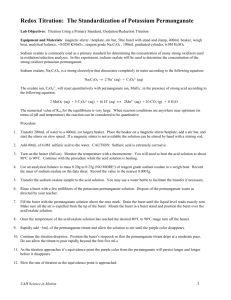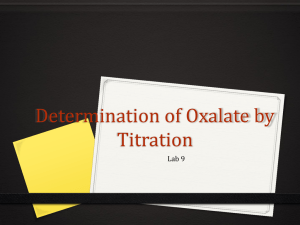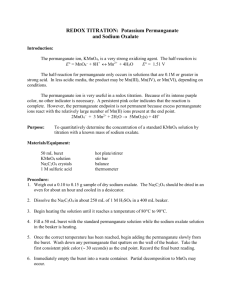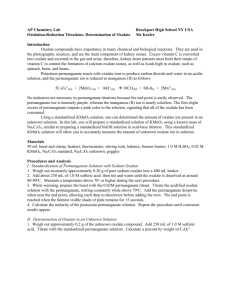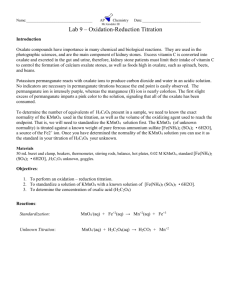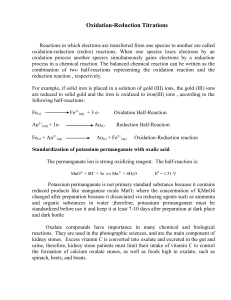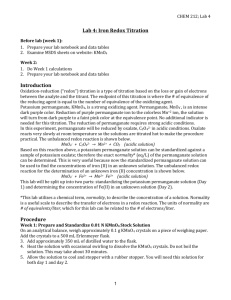The Determination of Oxalate Ion in Ferric Oxalate Trihydrate using Titrimetry
advertisement
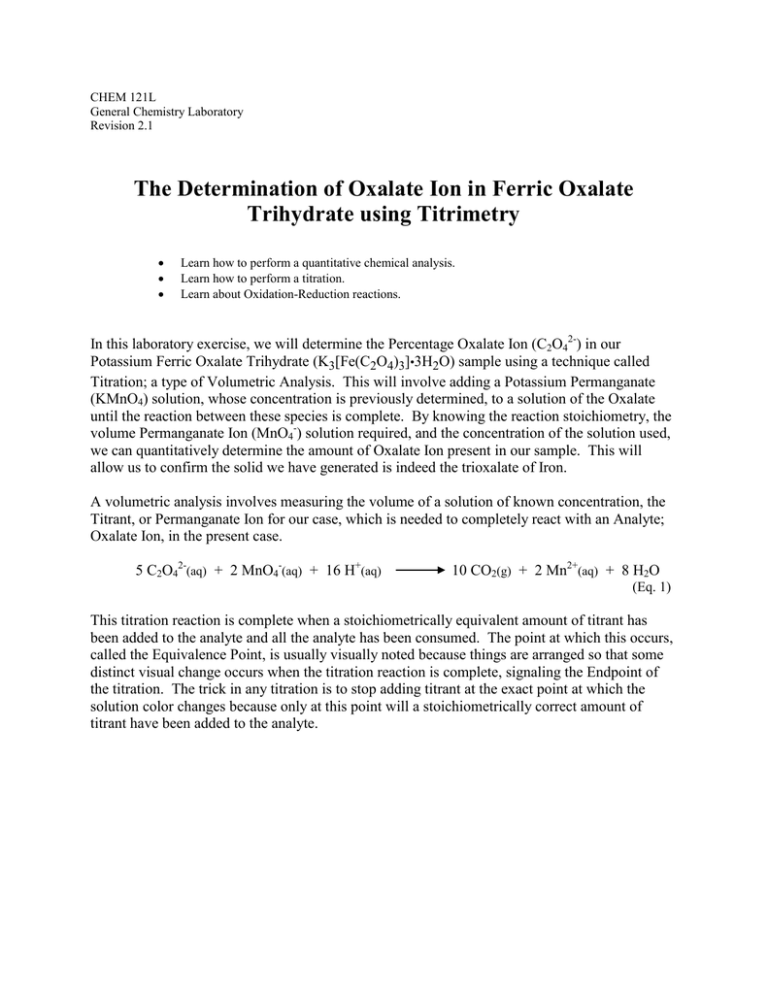
CHEM 121L General Chemistry Laboratory Revision 2.1 The Determination of Oxalate Ion in Ferric Oxalate Trihydrate using Titrimetry Learn how to perform a quantitative chemical analysis. Learn how to perform a titration. Learn about Oxidation-Reduction reactions. In this laboratory exercise, we will determine the Percentage Oxalate Ion (C2O42-) in our Potassium Ferric Oxalate Trihydrate (K3[Fe(C2O4)3]•3H2O) sample using a technique called Titration; a type of Volumetric Analysis. This will involve adding a Potassium Permanganate (KMnO4) solution, whose concentration is previously determined, to a solution of the Oxalate until the reaction between these species is complete. By knowing the reaction stoichiometry, the volume Permanganate Ion (MnO4-) solution required, and the concentration of the solution used, we can quantitatively determine the amount of Oxalate Ion present in our sample. This will allow us to confirm the solid we have generated is indeed the trioxalate of Iron. A volumetric analysis involves measuring the volume of a solution of known concentration, the Titrant, or Permanganate Ion for our case, which is needed to completely react with an Analyte; Oxalate Ion, in the present case. 5 C2O42-(aq) + 2 MnO4-(aq) + 16 H+(aq) 10 CO2(g) + 2 Mn2+(aq) + 8 H2O (Eq. 1) This titration reaction is complete when a stoichiometrically equivalent amount of titrant has been added to the analyte and all the analyte has been consumed. The point at which this occurs, called the Equivalence Point, is usually visually noted because things are arranged so that some distinct visual change occurs when the titration reaction is complete, signaling the Endpoint of the titration. The trick in any titration is to stop adding titrant at the exact point at which the solution color changes because only at this point will a stoichiometrically correct amount of titrant have been added to the analyte. Page |2 A Buret is the volume measuring device used to deliver the titrant into the analyte Solution. A Graduated 50 mL Burette (http://en.wikipedia.org/wiki/File:Burette_vertical.svg) This device is constructed such that it can be read with a high degree of precision. Accepted tolerances for burets are listed in the Appendix below. The amount (moles) of analyte present can be calculated from the volume of titrant added to reach the endopoint via: # moles Analyte = (Stoich. Ratio) x MTitrant x (Vf - Vi) (Eq. 2) Here, (Stoich. Ratio) refers to the reaction stoichiometry between the Titrant and the Analyte in the titration reaction, MTitrant is the molarity of the titrant solution and V is the buret's volume reading. Once the number of moles of Analyte has been determined, its mass can then be calculated using its molecular weight. In the present case, the titrant is Permanganate Ion (MnO4-) and the analyte is Oxalate Ion (C2O42-). Page |3 We will be performing a Redox Titration because our titration reaction involves an Oxidation of the Oxalate Ion (C2O42-) by the Permanganate Ion (MnO4-) solution: (Eq. 3) For our titration, the Endpoint is signaled by a change in color from clear to pink-purple. The Permanganate Ion is dark purple and its reaction product, the Manganous Ion (Mn2+), is only very Page |4 faintly colored. As the Permanganate is added to the Oxalate solution, it is immediately converted into Manganous Ion; hence, the solution will remain clear. However, when a stoichiometrically equivalent amount of Permanganate has been added, the Oxalate is completely consumed and any additional Permanganate will cause the solution to change color. Because at this point the Permanganate is so dilute, it will appear pink, rather than purple. Thus, we will add Permanganate to the Oxalate solution until we observe the first signs of a color change. At this point we will have reached the titration’s Endpoint, which is also the point at which a stoichiometric amount of Permanganate has been added to the Oxalate; the Equivalence Point. It should be noted, the quality of the titration depends entirely on the ability of the titrator to stop the addition of titratant precisely at the Endpoint. Thus, it is very important to approach the Endpoint slowly, adding one drop at a time until the Endpoint is reached. At the Equivalnce Point, because the amount of Permanganate added is stoichiometrically equivalent to the Oxalate, we have: (Eq. 4) Now, how do we know the concentration of the Permanganate Ion in the titrant solution? We cannot simply determine it from the mass of the KMnO4 used to prepare the solution. This is because the Permanganate Ion is light sensitive and decays over a period of time. Instead, we obtain the Permanganate concentration by Standardizing the solution. In the Standardization procedure, the Permanganate solution is used to titrate a known amount of a Primary Standard; a stable solid whose mass can be determined with considerable precision. In our case, the Primary Standard is Sodium Oxalate (Na2C2O4). This solid will act as a source of Oxalate Ion when dissolved in an aqueous solution: Na2C2O4(s) 2 Na+(aq) + C2O42-(aq) (Eq. 5) Titration of a weighed amount of Sodium Oxalate will allow us to determine the amount of Permanganate Ion in the titrant solution, and hence its concentration. Thus, we will first Standardize a solution of Potassium Permanganate. This will then be used to titrate a solution prepared from our compound containing the Oxalate Ion. This will allow us to confirm the amount of Oxalate in the compound is indeed correct. If the percentage Oxalate present is not consistent with the percentage calculated from the chemical formula, the sample is likely contaminated or does not contain the correct compound. Page |5 Pre-Lab Questions 1. Suppose 35.68 mL of 0.01015M KMnO4 is required to titrate 3.576g of a sample containing C2O42-. What percentage Oxalate is present in the sample? 2. Our titration reaction is performed at 60oC. There are two reasons for doing this. Provide at least one of these reasons. Page |6 Procedure Standardization of the Permanganate Solution 1. Thoroughly clean a buret, draining the wash solution and rinse Water (once with tap and twice with deionized) through the buret tip. Rinse the buret twice with ~2mL of the KMnO4 solution and dispense through the buret tip. Fill the buret with KMnO4 solution. Remove any Air bubbles from the tip. Allow the solution to stand for ~30 seconds and read the volume to a precision of 0.02mL. (Failure to record and use the correct number of significant figures in this experiment will be penalized severely.) Because of the intense color of the Permanganate solution, read the top of the meniscus. (The buret is a precision instrument and can give very accurate volume readings if used correctly. Consult with your laboratory instructor to make sure you are using and reading the buret correctly.) 2. Your laboratory instructor will demonstrate the correct use of the buret. 3. Weigh approximately 0.11g Na2C2O4 on glazed weighing paper using an Analytical Balance. Record the weight using all the permissible significant figures. 4. Transfer the Sodium Oxalate sample to a 125 mL Erlenmeyer flask and add ~30 mL of deionized Water and 5 mL of 6M H2SO4. Swirl to dissolve the sample. Wash any remaining Sodium Oxalate from the glazed weighing paper using a small portion of deionized Water from your wash bottle. 5. Heat the sample to about 60oC over a direct flame. Do not boil the solution. Remove the flask from the heat. 6. While still warm, titrate the sample with the (~0.01M) Permanganate solution until a pink color persists for about 30 seconds. Record the Endpoint volume to a precision of 0.02 mL. (Titrations are typically performed in triplicate. The first titration is used to estimate the volume required to reach the Endpoint. The remaining two titrations are then performed with a great deal of care.) 7. Repeat this titration twice more, with two new samples of Sodium Oxalate. 8. Calculate the concentration of the Permanganate solution. Titration of Potassium Ferric Oxalate Trihydrate 1. Prepare 3 samples of Potassium Ferric Oxalate Trihydrate (K3[Fe(C2O4)3]•3H2O) for analysis. Weigh about 0.1g of the sample on glazed weighing paper using an Analytical Balance. Transfer the sample to a 125 mL Erlenmeyer flask. Add 30 mL deoionized Water and 5 mL 6M H2SO4. Rinse the glazed weighing paper with a small portion of deionized Water from your wash bottle into the flask. Swirl to dissolve the sample. Page |7 2. Heat the sample to about 60oC. 3. Titrate the sample to the pink Endpoint. 4. Repeat this for two additional samples. 5. Calculate the percentage oxalate in the sample. 6. Dispose of any excess Permanganate solution in the appropriate waste container. Page |8 Data Analysis Standardization of the Permanganate Solution 1. Calculate the number of moles Na2C2O4 used in each of the three samples. 2. Calculate the concentration of Potassium Permanganate in the Standard Solution for each of the three titrations you performed. 3. If the first of the three titrations was crude, discard this result. Otherwise, include it. Average the titration results to determine the concentration of Permanganate in the Standard Solution. Titration of Potassium Ferric Oxalate Trihydrate 1. Calculate the number of moles Oxalate present in each of the three samples using the titration data. 2. Calculate the number of grams Oxalate present in each sample. 3. Calculate the weight percentage Oxalate in each sample. 4. If the first of the three titrations was crude, discard this result. Otherwise, include it. Average these results to determine the average Weight Percentage Oxalate. 5. Using the chemical formula, calculate the percentage Oxalate in Potassium Ferric Oxalate. 6. Calculate the percentage error in your analysis. 7. Comment on the results. Specifically, is your analysis in error? Or , is any error you observe associated with the quality of the sample? Page |9 Post Lab Questions 1. Suppose a drop of Permanganate titrant adheres to the wall of a dirty buret during the Standardization. Explain how this error affects the determination of the Permanganate concentration. 2. Normally, when reading the volume of Water in a buret, volumetric flask, pipet or graduated cylinder we read the bottom of the Water’s meniscus. Why do we read the top of the meniscus in this case? Will this affect our results? Explain. 3. During the titration of the Potassium Ferric Oxalate Trihydrate with Permanganate, only the Oxalate Ion, and not the Ferric Ion (Fe3+), is titrated. Why is the Ferric Ion not also oxidized in this titration? 4. Suppose we have a sample containing Ferric Ion (Fe3+) and we wish to determine the amount of Iron present using a Permanganate titration. How might we treat the sample so as to make this possible? 5. If the titration is carried out too rapidly, a brownish solid will form. What causes this? (Hint: Consider possible intermediate oxidation states of Manganese.) P a g e | 10 Appendix - Tolerances for Class A Volumetric Burets at 20oC Capacity (mL) 5 10 25 50 100 Tolerances (mL) 0.01 0.02 0.03 0.05 0.20 With the exception of Graduated Cylinders, the Tolerances for Class B devices is typically twice that of a Class A device. (ASTM E694)
